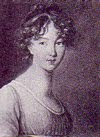
"Household in the old Dutch Colony times" from the History of the City of New York from its Earliest Settlement to the Present Time (New York: Clark & Meeker, 1859), Booth, Mary L. (Mary Louise) (1831-1889), Author; PC NEW YC-Lif-16; Record ID: 693395; Digital ID: 805606, New York Public Library, Mid-Manhattan Picture Collection (New York City -- life --1669 and earlier)

Washington Irving (1809) by John Wesley Jarvis (1781?-1839), oil on wood, SS.62.2 a-b, Historic Hudson Valley, Tarrytown, New York (image from
http://www. hudsonvalley.org/)
2009 marks the 200th anniversary of the publication of A History of New York From the Beginning of the World to the End of the Dutch Dynasty by Diedrich Knickerbocker, but really by Washington Irving (1783-1859) as well as the 150th anniversary of Irving's death on November 28th. A History of New York is a satirical, sometimes biting, account of the early settlement of the Dutch colony. It set in stone, however, as Irving's works often did, language and traditions we still hold today, such as St. Nicholas "riding jollily among the treetops, or over the roofs of houses, now and then drawing forth magnificent presents from his breeches pockets, and dropping them down the chimneys of his favorites." (Book III, Chapter II.)
Irving, who grew up in a New York which still retained Dutch influences and elements, wrote very detailed descriptions of the colony's first households and its inhabitants. He describes the families as "generally" living "in the kitchen", enjoying the warmth and light of "the fireplaces" which were of "a truly patriarchal magnitude where the whole family...enjoyed a community of privilege..." and the "goede vrouw...would employ herself diligently in spinning yarn or knitting stockings." (Book III, Chapter III) Even at "tea-parties," "the young ladies seated themselves demurely in their rush-bottomed chairs, and knit their own woolen stockings...behaving, in all things, like decent, well-educated damsels." (Book III, Chapter III.) These stockings are further described as "generally of blue worsted with magnificent red clocks" (Book III, Chapter IV) and as "The wardrobe of a lady was in those days her only fortune...she who had a good stock of petticoats and stockings, was as absolutely an heiress..." (Book III, Chapter IV.)
One of the most distinguished members of the colony was Peter Stuyvesant, who had only one leg but "was especially noted for having his sound leg (which was a very comely one) always arrayed in a red stocking and high-heeled shoe." (Book VII, Chapter I.)
The post above above this one (since I cannot seem to squeeze in a third photo in this post) describes my knitted commemoration of these anniversaries. 2009 is a busy year for it also marks the 400th anniversary of Henry Hudson's arrival in what is now New York, the 200th of the patent of Robert Fulton's steamboat and and the 100th of the 1909 Hudson-Fulton Celebration. I have not yet decided if and how I will commemorate those events in stitches although anything to do with ships is intensely inviting to me.

















